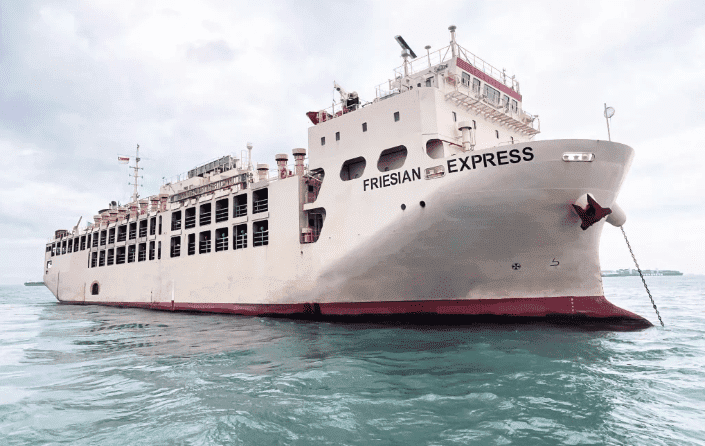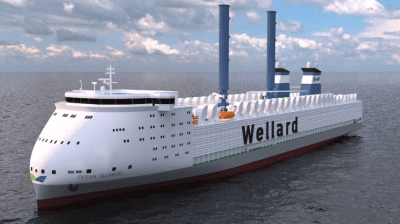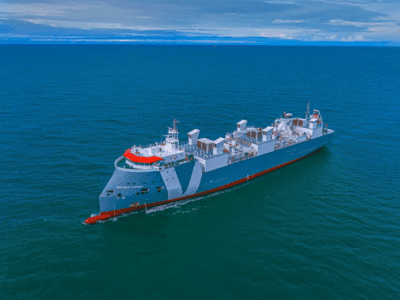
Livestock shipping company Livestock Express has expanded its fleet with the acquisition of the Aurochs, a purpose built-livestock carrier launched in 2017.
The purchase of the Aurochs from Japan’s Tsuneishi Group takes the number of dedicated livestock vessels owned and operated by the Singapore-based Livestock Express, which is owned by Dutch shipping company Vroon, from 12 to 13.
The Livestock Express fleet is made up of dedicated purpose-built livestock carriers, which are contracted by export companies to transport as many as 750,000 head of livestock, including cattle, sheep, horses, and goats, on trade lanes around across the world annually.
The Aurochs has been renamed the “Friesian Express” following its sale to Livestock Express, which names all of its livestock ships after breeds of livestock followed by the suffix “Express”.
The Aurochs had been under the commercial management of Livestock Express since 2020 and was seen as a natural fit for the business, Vroon group legal manager Christopher Savoye said.
The vessel, which has a capacity of 2300 cattle, has already conducted its first journey under its new ownership, departing Australia on January 23 for Pakistan.
It is estimated that there are more than 150 livestock carriers operating around the globe, but only about 30 are able to meet the accreditation standards required to export livestock from Australia.

The Ganado Express, was among the first of the Livestock Express G-Class vessels to be launched in 2013.
Fewer than 20 purpose-built livestock vessels have entered the worldwide fleet throughout history, according to the company, of which 13 were designed and built for Livestock Express.
The oldest vessels in its fleet were constructed in the late 1990s, while seven built as part of a fleet-renewal program between 2013 and 2016.
These are known as the “G-Class” vessels, with each named after cattle breeds starting with ‘G’ – ie the Galloway, Ganado, Gelbray, Girolando, Gloucester, Greyman and Gudali Expresses.
The G-Class vessels regularly transport livestock from Australia.
Livestock express said the vessels were designed with wave-piercing bows to ensure maximum comfort for livestock and crew while maintaining high speeds, and have ducted ventilation systems which provide each individual pen with fresh air directed to the skin surface where most heat is generated from the livestock.
Are new ships in the pipeline?
At seven-years old, the Aurochs (now Friesian Express) is the newest ship servicing the trade.
It is followed by the eight-year old Wellard-built Ocean Shearer constructed in China in 2016, which is now now named the Al Kuwait under the ownership of the Kuwait Livestock Transport & Trading, and Livestock Express’ seven G-Class vessels which vary from eight to 10 years old.
Beef Central’s research in 2020 indicated that the global average age of livestock vessels in that year was 37 years, while the average age of vessels accredited to export from Australia was close to half that figure, at an average of just under 20 years.
There are no new purpose-built livestock export ships currently in the pipeline to be built that Beef Central is aware of.
 At its annual general meeting in 2022 Wellard revealed conceptual plans for the world’s first “wind-assisted” livestock carrier, to be named the Ocean Jillaroo.
At its annual general meeting in 2022 Wellard revealed conceptual plans for the world’s first “wind-assisted” livestock carrier, to be named the Ocean Jillaroo.
Chairman John Klepec noted in his presentation that there were significant advantages to operating modern vessels, which included enhanced animal welfare outcomes, reduced operating and maintenance costs and lower carbon emissions.
But he said at the time that sky-rocketing construction costs had resulted in Wellard pausing its replacement program until ship building costs normalise.
More than a year later there are still no firm plans to build a new vessel.
The decision by the former Ardern Government to end the live trade from New Zealand (though possibly returning with more strict safety oversight and ‘a purpose-built vessel-only’ policy under the new Luxon NZ Government) and the Albanese Government move to phase out live sheep exports offers little confidence to shipping companies to invest in new builds, particularly when construction costs remain high.
If New Zealand reinstates livestock exports as suggested by its new Government under new “Gold Standard” rules which would require purpose-built only vessels and an age-limit, that would potentially provide some incentive for new builds, trade sources suggested to Beef Central this week.
A spokesperson for Livestock Express told Beef Central that there are no new livestock carriers on order to the best of its knowledge.
“Shipyard capacity has been limited and construction costs have escalated in recent years. We continue to assess if market conditions would make for a viable business case for a new built.”
Vessel purchase backed by confidence in future
Asked more specifically about why it has invested in more livestock shipping at a time when some countries are either banning, or talking about banning, livestock exports, the company said it believed livestock exports have a positive and long-term future if sub-standard vessels and operators are forced to exit the market.
Vroon group legal manager Christopher Savoye said a consistent, strict and enforceable regulatory framework is critical for the future of the trade.
“Our key concern would be that countries without strict regulation fail to implement new regulation creating an uneven playing field.
“This would ultimately be at the detriment of animal welfare on a global level as export volumes shift from regulated to non-regulated countries,” he said.
Mr Savoye said Vroon has been active in the live export industry since 1964 and it is considered one of the group’s core markets.
Mr Savoye said Australia remains the most strictly regulated country in the world when it comes to livestock carriers and operating costs are considerably higher as compared to vessels that trade in less strictly regulated areas.
“The high operating costs combined with tough trading conditions in recent years has resulted in a reduction of vessels approved to trade from Australia.
“Livestock Express firmly believes that there will demand for modern, purpose-built livestock carriers able to transport livestock in safe manner and up to the highest animal welfare standards.”
On the potential banning of livestock exports from major livestock-producing countries, Mr Savoye said livestock producing countries such as Australia have an important role to play in the world when it comes to food security.
“Especially when you consider its geographical proximity to the Asia Pacific region with expected population growth in the years to come.
“The live export industry and our vessels have an important role to play in this,” he said.
“We have invested heavily in assets that assure the safe transportation of livestock up to the highest animal welfare standards.”
Mr Savoye said Livestock Express predominantly ships cattle.
“We have however observed a significant increase sheep trade from EU to the Middle East in recent years.
“Unfortunately most vessels on this trade are of questionable quality flying grey or black listed flags,” he said.
“Whilst most of our vessels are capable to transport sheep from Australia we have not exported sheep from Australia for a number of years as sheep-shipments typically are conducted on larger sized vessels,” Mr Savoye said.
“As a premium operator operating in strictly regulated markets, Livestock Express has and will always focus on animal welfare.
“It is the key performance indicator and the reason our clients entrust their livestock to our company for transportation,” he said.
“Our vessels are purpose-build with the livestock at the centre of its design and with more safety systems and redundancy (for e.g. power supply, water production, ventilation and cargo hold cleaning systems) than seen on any other livestock vessels.
“Equally important is the training of crew and ensuring a minimum level of experience is present on board,” Mr Savoye said.
“We are proud to have a loyal crew pool and this is an important element of our service delivery.
“We also believe technology has a role to play,” he said.
“One example is the implementation of predictive maintenance for our machinery, where AI technology combined with sensor data can detect anomalies that can be addressed before they become issues.
Mr Savoye said one of the main risk factors in the international livestock shipment trade by sea is sub-standard vessels and operators conducting significant volume of business and even taking business away from strictly regulated countries.
“This is a major risk and concern for the trade.
“Live export by sea can be conducted safely, but it requires high standards throughout the supply chain.”
“When it comes to livestock transportation we would welcome stricter regulation and enforcement to create a level playing field and ascertain the safety of any vessel transporting live animals.
“Loading densities should be part of such regulation, but evenly important is the monitoring and enforcement of such regulation.”

